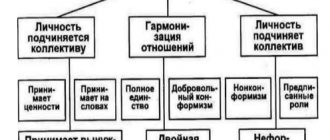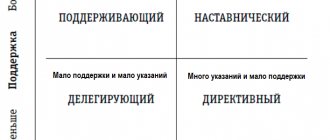Adviсe
- Psychological climate in the team. Basic Concepts
- Factors influencing the psychological climate in a team
- Social tension in the organization. Strategies to reduce
- How to improve the psychological climate in a team
Everyone would like to find a job where they pay well, the team is pleasant, there is no overtime, and the entire social package is available. Such information is indicated in almost 99% of resumes on various job search resources. But employers offer fewer benefits, but many requirements with little pay. Of course, it is also important for them to find a suitable candidate, and also to achieve high productivity with minimal effort on their part.
Positive sentiment among employees always has a positive impact on the work process and productivity.
Large companies successfully apply the principle of working with employees not only to improve their skills, but also to normalize the psychological climate in the team. Unfortunately, many medium and small companies do not pay attention to this problem, which becomes the cause of many difficulties.
Definition of the concept
What is the psychological climate in a team? This is the moral and psychological situation in the group. It is detected and manifested primarily in the emotional sphere: the mood of each participant, the system of likes and dislikes, the moral values of each member of the group. What else determines the psychological climate in a team? Through it, the attitudes and habitual patterns of behavior of the participants are determined and reflected, including the usual ways of achieving personal and common goals, building relationships, resolving conflicts, etc.
In Russian psychology, the concept of “psychological climate in a team” was introduced by psychologist N.S. Mansurov (late 50s - early 60s of the XX century). However, in psychology there is still debate about the identity of the terms “psychological climate” (PC), “socio-psychological climate” (SPC) and “moral-psychological climate” (MPC). Most psychologists believe that they are one and the same thing. Other experts see the difference in emphasis and continue their research. In short, the following features of the concepts are highlighted:
- PC reflects the specifics of the individual’s interaction with the social environment (work collective) and with the physical environment (working conditions). This concept is more often used when describing and studying the mental state of individual team members.
- SPC reflects the specifics of the individual’s interaction with the social environment. This concept is more often used when describing the interpersonal relationships of team members.
- The IPC reflects the characteristics of the attitude of team members to each other, work and life of the organization based on personal values. This concept is more often used to describe how the well-being of each of the participants affects their productivity, relationships with other team members and attitude towards work.
Some psychologists, for example, G.A. Vinogradov distinguishes additional types of PC (besides those that we have already considered): emotional-psychological and moral-psychological climate. In this article we will not delve into the intricacies of concepts and will consider the phenomenon in general terms - the psychological climate in a team. And we will consider the SPK and IPC as components of the PC.
Important! The mood, attitudes, values, beliefs, and interests of team members influence the PC, but at the same time, the PC (general atmosphere) influences the mood, attitudes, and values of individual team members.
Satisfaction as a criterion
The basis for climate assessment is people’s satisfaction/dissatisfaction with relationships in the team and the activity itself. However, you need to understand that satisfaction can be subjective and objective.
It often happens that one person is completely satisfied with the team, while another is not at all satisfied with the working conditions. This is subjectivity in assessment. Differences in experience, conditions and quality of life, interests, character of people and other individual characteristics contribute. The principle of subjective satisfaction is the relationship between the parameters “I give” and “I receive”.
Dissatisfaction with delayed wages, regular punishments, non-compliance with labor standards, violation of rights is an objective indicator.
Climate structure
The structure of the climate in the workforce includes two elements:
- Relationship between people.
- Attitude to work.
Interpersonal relationships are of two types (branch to the side in the structure):
- horizontal relationships, that is, between subordinates;
- vertical relationships, that is, between subordinates and superiors.
Each of the three types of relationships affects team cohesion, employee satisfaction and their motivation to continue working in this team.
Democratic style
This type of management is based on very trusting and friendly relationships between all team members, as well as goodwill and sociability. In this case, all responsibilities, powers and initiatives are distributed between the manager, his deputies and subordinates. All decisions are made collectively.
The director, who has adopted a democratic management style as a basis, cares about the opinion of his subordinate team regarding key production issues. Communication between the manager and employees occurs exclusively in the form of wishes, requests, advice and recommendations.
Rewards for quickly and efficiently completed work are not excluded. Communication takes place in a polite and friendly manner. If necessary, orders are used (extremely rarely).
Favorable and unfavorable climate
PC can be favorable or unfavorable. In the first case, all participants feel good, and the common cause is going well. In the second case, you can feel the intensity of emotions in the team, conflicts often arise, and the participants are stressed.
Let us consider in the form of a comparative table what is typical for the two types of psychological climate.
| Comparison criterion | Favorable climate | Unfavorable climate |
| Mood | Optimistic | Pessimistic |
| Cohesion | Group members support each other, help each other | There is disunity, envy, hatred |
| The nature of interpersonal relationships | All participants are friendly | Aggressive behavior predominates |
| Working atmosphere | Everything works out easily and naturally, all employees are aimed at success and put forward adequate demands on each other | There is tension in every action, there is fear of punishment, team members are too demanding of each other or, conversely, there is permissiveness |
| Communication | Team members interact openly with each other | Each of the participants is concerned only with their own problems, is cold towards others, closed |
The formation of a favorable psychological climate in the team is vital for the organization. Under such conditions, labor productivity and productivity of each employee increases, and the risk of accidents and conflicts in production is minimized. All managers strive to create a favorable PC in the team.
Note! With a healthy PC in a team, both the individual needs of the participants and the overall goals of the group are satisfied. At the same time, the tasks and actions of the team do not contradict the norms and laws of society.
We are constantly monitoring the situation
The climate within the same team changes over time. This may be due to the external environment - for example, during a crisis, all relationships become strained, much more effort is required from the team, and fear of dismissal arises.
The situation within the team can also change, since the emotional background directly depends both on the leader, who may have different periods in his life, and on the team members, whose life situation, emotional background, roles and positions, goals and priorities may also change. .
Levels
In psychology, it is customary to consider the psychological climate at two levels (two types):
- Static level. This is that part of the climate that is determined by the stable characteristics of the team: the system of likes and dislikes, attitude towards work, values and beliefs of employees. This level of climate is resistant to the influence of negative external factors. Reaching this level is the height of mastery. A static climate is typical for older groups, but even such groups do not always manage to reach this level.
- Dynamic level. This is the part of the climate that changes daily and depends on mood, current life problems and important events in the lives of workers. This level is typical for fresh, young teams. However, even in an old team there can be a dynamic, that is, unstable climate. He is weak to the influence of external factors.
In a static climate, participants feel safe. At the dynamic level there is tension, a feeling of instability.
Man in a case
Remember Chekhov’s character Belikov, who always lamented: “No matter what happens.” In real life, this type is not so rare.
This is a man who seems to love nothing more than to prohibit and restrict. Rules and norms mean more to him by default than living people
The man in the case can be found in the legal or financial department. Among tables and reports, he feels like a fish in water. But interference in this order by the human factor - emotions, inaccuracies, mistakes - can seriously throw it out of balance.
Why is it dangerous?
Such a person, because of his tediousness, is the main troublemaker in an informal company. And in the working environment, he cuts down in the bud any undertakings that are too bold and risky, from his conservative point of view. He will torment you with meticulous reporting requirements and will not forgive a single sloppy check.
Why does he behave this way?
The man in the case is not just responsible, pedantic and conservative. He is also very anxious. He prohibits, limits and plays it safe out of fear that something will really go wrong - and the organization (and therefore himself) will have problems.
This fear is to some extent adequate, because a frivolous person would not be entrusted with working with finances. But anxiety can be very exaggerated, which is why anything can be banned - just to be on the safe side.
How to neutralize. Probably the simplest strategy is to politely listen to his opinion, perhaps even agree with him in words - and do it your way. Or look for other supporters of your ideas in the organization. Playing on the territory of a man in a case is useless: your resistance to his demands will only strengthen him in the opinion that your ideas are dangerous and must be suppressed.
Signs
To diagnose the state of the psychological climate in the group, special psychological tests were developed (we will talk about them in the “Diagnostics” section of this article), but besides this, the psychological climate in the team is determined by external general signs.
Signs of an unfavorable psychological climate:
- high staff turnover;
- low quality product;
- frequent accidents at work;
- negative feedback from employees.
Signs of a favorable psychological climate in a team:
- democratic leadership style;
- an adequate system of punishments and rewards;
- constructive criticism;
- mutual assistance and a high level of empathy;
- a sense of group cohesion and responsibility for oneself and the entire production;
- positive feedback from employees.
The psychological climate is influenced by personal and collective factors. Let's take a closer look at them.
Looking for the weak link
Another factor that affects the team climate is an employee who is toxic to the team. I have a client - a large pharmaceutical company, in whose marketing department one of the employees was critical of the manager and practically created an opposition group against him.
As a result, employees, instead of working to achieve ambitious goals for promoting new drugs to the market, spent their time and energy on endless discussions and gossip. In such a situation, the only possible solution was to fire the destructive employee.
Test: find out if you can competently enter the market in another country
Another example. In a large manufacturing company, at a certain moment, the plant director entered into a state of conflict with almost all related departments; the company management understood that a difficult and stressful climate had developed, but they were in no hurry to part with the director due to the fact that his qualifications were unique in the industry.
As a result, the shareholders talked with the director of the plant, tried to get the most open feedback, and it became clear that the conflict situation and difficult climate arose due to the fact that the director felt personally responsible for the commissioning of the new line, but was faced with a large number of problems related to failure to meet deadlines and promises from other departments and external contractors, and in connection with this he panicked, became stressed and lashed out at his employees.
They hired an experienced deputy, helped him with planning and gave him more authority, after which the situation leveled out and the climate in the team became much more friendly.
Factors influencing climate
Personal factors influencing the psychological climate in the organization:
- Job satisfaction. Some people like the same type and monotonous activities. Some people need activity and multitasking. Some are more diligent, others less. Some are masterfully creative, while others work perfectly according to instructions. Work tasks must correspond to the characteristics of the individual, then the person will be satisfied with himself, and this, in turn, affects the creation of a favorable psychological climate in the team.
- Career prospects. Of course, there are people who are comfortable being in the same position for many years, receiving the same salary. But most people are interested in career growth. This increases motivation, as does an adequate system of rewards and punishments. The more freedom, rights, and opportunities employees have, the more favorable the psychological climate in the team.
- Convenient workplace. And we are talking not only about physical convenience, but also about psychological comfort. Some people can only work in silence, while others find it important to constantly discuss issues with colleagues. Some people need privacy, while others cannot work alone. Some people can't stand the heat, and some people can't stand air conditioning, etc. Working conditions must correspond to the needs and characteristics of the employee, then he will be satisfied and happy, which, in turn, has a positive effect on the general psychological climate in the team.
- Personal time. The importance of weekends and working strictly according to schedule cannot be underestimated. If there are overtimes or work on days off, then this must be paid and compensated next time. Employees should have a personal life, the opportunity to make plans, and spend time with friends or family. The right to privacy contributes to the creation of a favorable psychological climate in the team.
- Microclimate in the family, features of the personal life of employees. Problems in the family or worries due to loneliness cannot but affect the employee’s mood. Later he will bring the negative with him to production. For this reason, large companies organize family vacations, sponsor trips to a sanatorium for the children of employees, etc. Employers try to take care not only of the health and happiness of employees, but also of the well-being of their families.
General factors determining the formation of the socio-psychological climate in a team:
- Compatibility of views, beliefs and attitudes, temperaments and characters. The more employees have in common, the easier it is for them to interact with each other and focus on the overall result of the business. Moreover, there is no need to strive for the similarity of all employees of the company; it is enough to correctly distribute people among departments, offices, and simply among desks within the same room. It does not happen that absolutely all people have a positive attitude, that the habits and beliefs of all participants coincide. Therefore, it is more appropriate to say that we need to strive for harmony and balance in the team, and not to eliminate all negative factors.
- Psychological cohesion and harmony. In a friendly team with a favorable climate, all problems are solved easily and quickly. Cohesion can be achieved with the help of corporate culture and psychological training. In addition, the professionalism and competence of each team member is important. Every person must understand that he is responsible not only for himself, but also for others.
- Leadership style. It can be democratic, authoritarian and permissive. To create a favorable psychological climate in a team, it is important to adhere to a democratic style.
- The nature of communication. A favorable psychological climate arises in those teams where people know how to communicate openly and honestly, empathize, and help. The ability to prevent and resolve conflicts, make compromises, and look at the situation through the eyes of another person is valued. In addition, it is important to be able to defend your interests, but not to offend the interests of your colleagues. You need to be able to accept constructive criticism and express it.
When working with factors influencing climate, one must avoid maximalism. For example, regarding the last point, this means the following: you do not need to recruit exclusively sociable and active people. Silent and quiet people also know how to perfectly complete tasks and express their opinions if asked about it. For each item of factors, balance is important.
Recommendations
- Highlight informal leaders, give them more power and encouragement, because they are the ones the team trusts, it is their opinion that the team will support, and seek help if difficulties arise. Therefore, if the unspoken leader respects and values you, then when collaborating with him, you can be sure that everyone else will share his opinion, with the exception of special instances. And to become the most chosen group, look at the article about ways to develop leadership qualities in yourself.
- For conflict resolution, see this article.
- If you manage to establish relationships with employees, do not forget about such a nuance as maintaining the created atmosphere in the group. As they say: “To break is not to build.” So try not to devalue or invalidate all your efforts. Literally one mistake at first will be enough for everything to go back. If you have changed your approach to colleagues and the work process, then no matter how you are provoked to return to a more familiar system, do not give in. Criticism and punishments must be fair so that no one can doubt your competence. Be sure to look at the rules and techniques listed here.
- Show by your own example how to talk to colleagues, support and help. If you are a leader, then prove that you trust your subordinates. Try to loosen control, give a more serious task and provide an opportunity to demonstrate your abilities by seeking advice in solving a difficult issue.
- Managers are not gods, no matter how geniuses they are, which is why they may well make mistakes. It is important to only be able to apologize to your subordinates; this will not make you weak, but on the contrary, it will strengthen your authority and show that you are also a living person. Learn, if you don’t know how, to make concessions and seek compromises with people, even those of lower rank.
- Choose your leadership style depending on the situation and environment. If you are authoritarian, then at the moment when the situation in the team reaches its peak, you risk receiving a lot of resignation letters, or, in extreme cases, frame-ups, slander, etc. Look at the model that scientists have developed for the very purpose of learning to determine when and how to behave.
Diagnostics
Is it possible to independently determine the type and level of psychological climate in a team? Yes, psychologist A.N. Lutoshkin developed a special questionnaire. The test is carried out by the supervisor. All employees answer, including himself. Each participant is asked to respond to 13 polar statements about the team with scores ranging from -3, which means “completely disagree,” to 3, which means “completely agree.”
Questions and statements of the questionnaire:
To summarize, you need to add up all the participants’ scores and divide them by the number of people surveyed. The final score is the score of the psychological climate in the team:
- from 22 points – stable favorable climate;
- from 9 to 21 points – average stability, favorable climate;
- from 1 to 8 points – low stability and favorable climate;
- from 0 to -7 points – unstable climate, close to unfavorable;
- from -8 to -10 points – unfavorable psychological climate, stability is maintained in some places;
- from -11 – unfavorable, unstable climate.
If a specific item on the questionnaire has attracted your attention, you can similarly calculate the overall score for it.
Consequences of a negative atmosphere in the team
If tension in a team persists for a long time, it will inevitably lead to negative consequences. Among the most likely:
- increased staff turnover: employees often leave of their own free will, while there were no prerequisites for this from management (for example, a salary reduction or a change in work schedule);
- “migration” of employees within the company: specialists from one of the departments turn to the manager with applications to transfer them to other departments;
- development of dissatisfaction among employees: topics of lack of prospects, comparisons with competing companies and discussion of the negative state of affairs become the main ones in communication;
- an increase in the number of disputes between employees: both in one division and between different departments;
- decreased labor productivity: it inevitably develops in a team where there is socio-psychological tension; as a result, the company begins to lag behind planned indicators, new and ongoing projects are under threat;
- decrease in the quality of the result: as a rule, it is observed in the area where there is moral tension.
An unfavorable atmosphere affects all team members. At some point, the manager is also drawn into it. If he does not strive to understand the reasons for what is happening and eliminate the root of the problem, his functions are reduced to resolving numerous current conflicts. At the same time, the manager’s time is distributed irrationally: conflicts do not allow him to focus on achieving the planned financial goal.
Creating a favorable climate
Why is a favorable psychological climate in a team necessary? It is the basis for the success of production (another business), the physical and mental health of team members. The more positive the general attitude, the faster and more efficiently things go, and common goals are achieved.
How to create a favorable psychological climate in a team? Methods for creating a favorable psychological climate in a work team can be divided into two categories: working with groups and working with each team member. Let's take a closer look.
Recommendations for working in groups:
- Conduct diagnostic tests to determine the compatibility of participants. Talk to them and identify any current problems. Change the composition of groups, transfer employees to other departments. For example, it turned out that one of the employees was in conflict with the entire other group because his personal needs were not met. Think about where this employee would be comfortable working and send him there.
- Set a goal or task for the team, for example, to fulfill a sales plan. Firstly, it will unite the team. Secondly, you will be able to identify weak links and destructive leaders. Perhaps in the process of work it turns out that some employees are working to the limit of their capabilities, while others are not participating in the common cause. Dismissal or redistribution of the latter will improve labor productivity and the psychological climate in the team.
- Organize free training courses, master classes or recreation for employees. At the same time, evaluate and, if necessary, change their jobs.
Recommendations for individual work with employees:
- a clear definition of the responsibilities, requirements and tasks assigned to the employee;
- tracking destructive leaders and conducting educational activities with those who spread rumors or undermine the authority of the manager or other employees;
- identifying informal positive leaders through whom you can influence other team members.
Recommendations for managers (on working on yourself):
- be principled and responsible;
- be active and proactive;
- maintain discipline in your own production;
- be open, kind and sympathetic, but avoid familiarity;
- improve your organizational skills;
- be consistent;
- treat your subordinates with respect and kindness;
- encourage initiative and independence of employees;
- motivate and encourage subordinates.
Recommendations for employees (on working on themselves):
- get rid of shortcomings and further strengthen strengths;
- develop morality and moral beliefs;
- develop empathy;
- increase stress resistance;
- maintain discipline and ethics, remember the corporate culture;
- master self-regulation skills;
- learn to resolve conflicts;
- take care of your physical and mental health, solve all life problems in a timely manner.
In order for a favorable climate to develop in the team, employees must clearly see, accept and understand common goals and personal goals. They, as well as the methods of achieving goals and solving problems, should not conflict with the personal interests and beliefs of employees.
Why is it needed?
A favorable microclimate makes it possible to feel the value of both your work (and, accordingly, your personality) and the enterprise itself. And as a result, respect for the leader arises, recognition of his management skills and a desire to cooperate with him, and not to compete or sabotage the process. The overall friendly atmosphere will be noticed by customers. The number of which will begin to grow thanks to the most effective method of advertising - word of mouth.
The main task of both small firms and large corporations is to create a comfortable work environment, devoid of tension, anger or fear. It is in such conditions that workers will be able to demonstrate their skills, make important decisions together and find ways to overcome difficulties. Because they have one goal - to promote their company.











